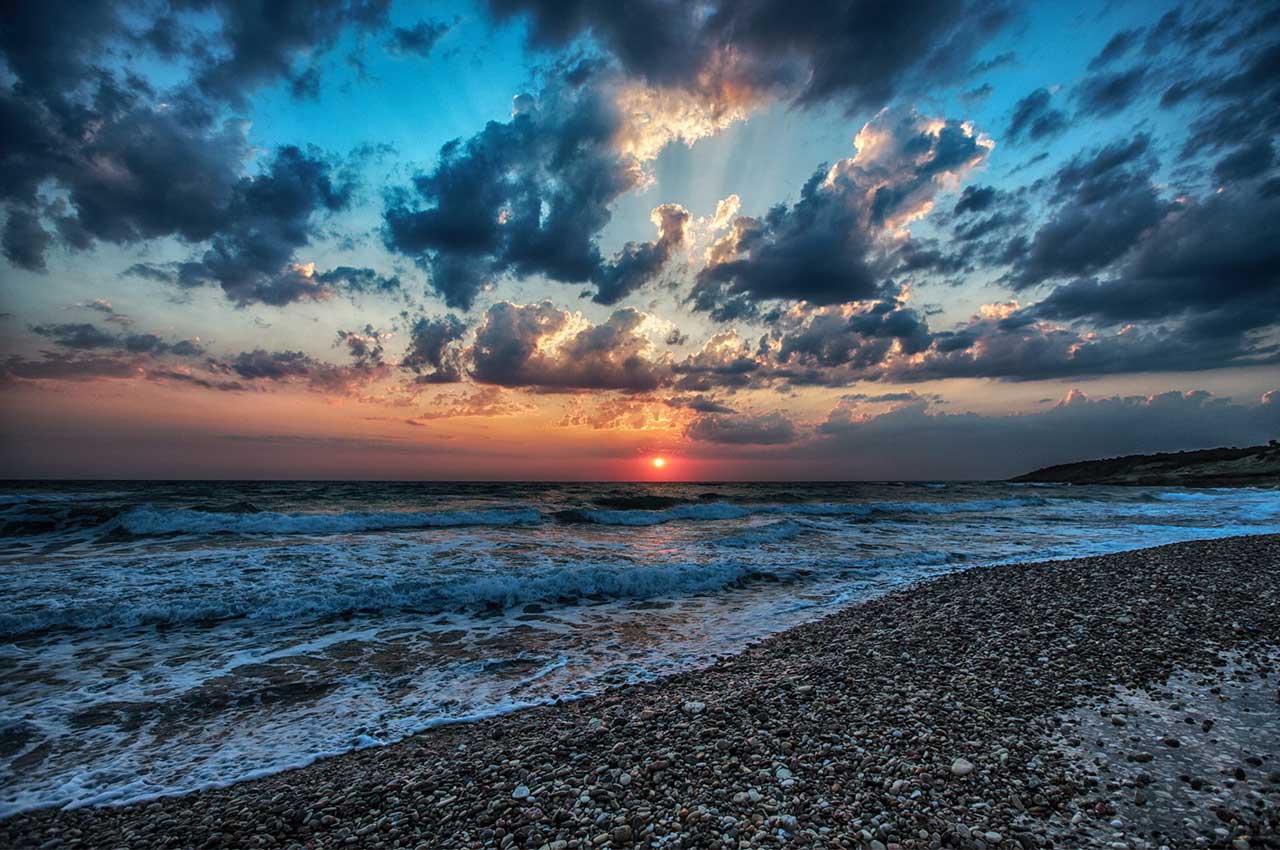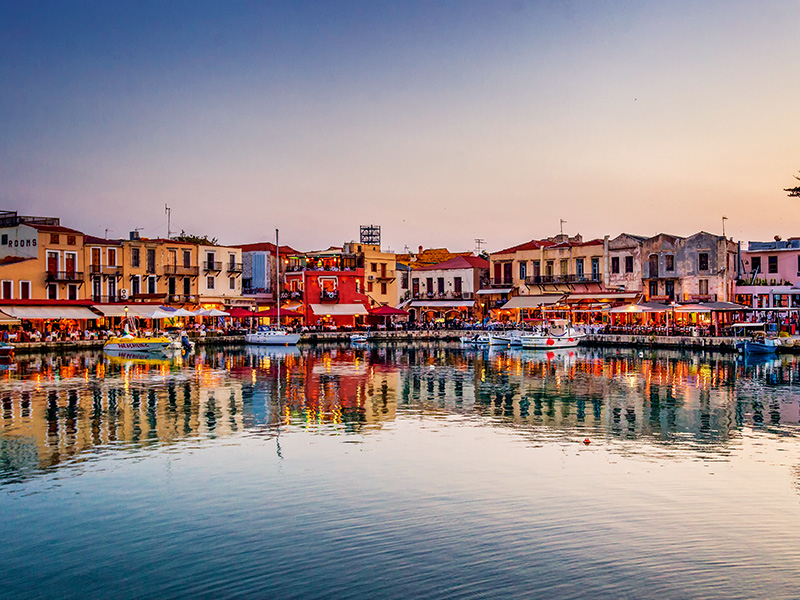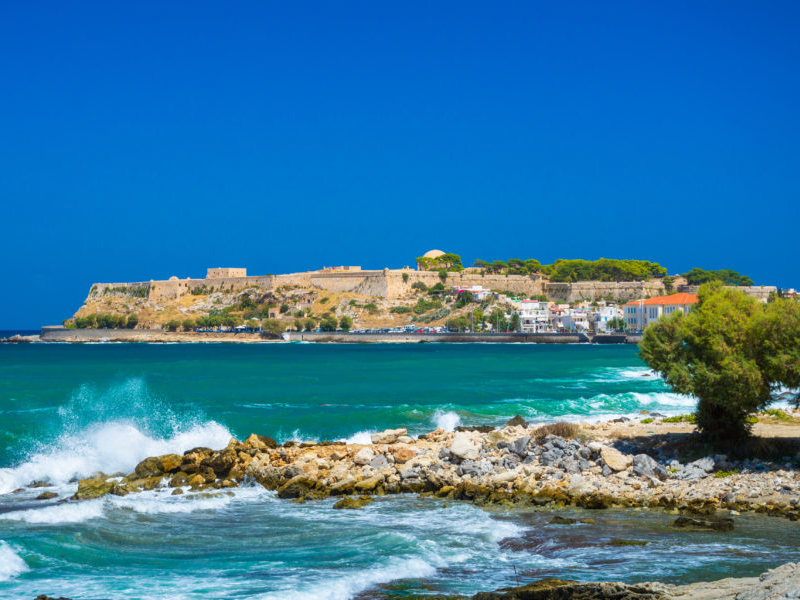Rethymno
Rethymno combines rarely united features: the old town’s charm and history. Although it is the third largest town in Crete, Rethimno never feels like a big city. It’s a place that moves slowly, a very romantic plade and the most important preserves much of its Venetian and Turkish appearance.
Rethymno Sightseeing
Fortrezza
The Venetian stronghold of Fortezza is built on top of a low hill above Rethymno Town, Crete. The hill is known as Paleokastro, which means old castle in Greek and suggests the existence of an older structure in that place. This huge fortress, with its turbulent history, was built between 1540 and 1570 by the Venetian maritime power as a bulwark against Turkish pirates.Venetian influences abound and the minarets and domed mosques remind of the Turkish influence long gone.
The Venetian harbor
Rethymno’s harbour area is a fine place for a coffee at one of the cafes and you have the change to eat something with a spetacular view.
Ottoman Baths in Rethymno
An interesting site of Rethymno is the Ottoman baths, also known as Hamam in Turkish. They are located in the Old Town. This construction is very well preserved today but the baths are not open to the public.
Rethymno Museums & Churches
Museums
Archaeological Museum of Rethymnon
The Archaeological Museum of Rethymnon has been housed since 1991 in the pentagonal building, which stands in front of Fortetza’s main gate. The exhibits give him a diachronic view of the cultural history of the prefecture from the Neolithic to the years of Roman rule.
Museum Of Contemporary Art of Crete
The Museum of Contemporary Art of Crete is located in the heart of the old town of Rethymnon. Its permanent collection of some 680 works comprise creations by the Rethymnian artist Lefteris Kanakakis which span all phases in his career as well as works by other contemporary Greek artists which cover the entire spectrum of the Greek contemporary artistic reality from 1950 to this day.
The Historical and Folklore Museum of Rethymnon
The museum is located in a 17th-century Venetian building in the Old Town. This museum was established in 1973 and aimed to collect and study folklore material from the region. Visitors can see exhibits from the 17th century until modern times.
Churches
Arkadi Monastery
Arkadi Monastery is located within 23 km from the city of Rethymno. They says that the name was given by a monk called Arcadius.
It is dedicated to the Transfiguration of the Savior and to the Saints Constantine and Helen.
Preveli Monastery
The important monastery of Preveli sits on the rocky hills of Preveli canyon. It consists of two monasteries, the Lower or Kato Preveli and the Upper or Pisso Monastery of Agios Ioannis Theologos, about 3 km far from Kato Preveli, which is dedicated to Saint John the Baptist. The monasteries date back to the middle 16th century. It is open to visit and offers excellent views to the mountainous landscape of Crete.
Rethymno Traditional Products
In Rethymno, you’ll enjoy culinary treats inspired by Crete’s flavourful cuisine and traditions. Restaurants in Venetian buildings with beautiful gardens, rakadika where you’ll complement meze with the local schnapps-like drink raki, and quaint little tavernas.
Rethymno Folklore Festivals and Cultural Events
Rethymno is a city with a long history. Throughout the year, many local festivals take place in the villages. These are religious celebrations and other events always accompanied by excellent wine, food, and music.
Religious Feasts & Festivals
- August 15th
On the 15th of August, celebrations are held to honor the Dormition of the Holy Virgin, the largest religious celebration in Greece. The great feast is accompanied by food, wine, and traditional dances.
- September 8th
On the 8th of September, in the village of Myriokefala, there is a lovely feast with hundreds of pilgrims. The locals celebrate the miraculous icon of Virgin Mary which is kept in the Byzantine church of the village.
- April 23rd
The feast of Agios Georgios is greatly celebrated in Zoniana and Plakias on April 23rd (or the first Monday after Easter).
Cultural Events
November 8th
On the 8th of November, the locals commemorate the Arkadi Holocaust. A religious ceremony is held in the monastery of Arkadi, where the Cretan fighters exploded themselves in 1866 in order to avoid surrendering to the Ottomans. where the locals bring flowers to the monastery to honor the dead.
Carnival of Rethymno
The Carnival of Rethymno is very popular in Greece. Festivities last for two weeks and include treasure hunts, musical events and a large parade in Carnival Sunday.
Renaissance Festival
The Rennaissance Festival takes place from late August to early September in various venues of Rethymno Town. The events include theatre performances of Medieval plays, concerts of Medieval age and exhibitions of baroque art.
Rethymno Beaches
Many beautiful beaches are found along the coasts of Rethymno. The beaches on the northern side are more organized and popular, lined up with hotels, restaurants, cafeterias and water sports centers. Opposite the beaches on the southern side remain untouched by tourism and ideal for total privacy. Some of them are :
Agia Galini Beach
The main beach of Agia Galini it is well-organized with sunbeds and umbrellas and has nice crystalline waters. The beach offers all kind of beach facilities and a wide range of water sports. On the east end of the beach, visitors will be able to find quieter spots for swim and a small river ending into the sea.
Preveli Palmgrove
The beach of Preveli, also known as “Phoenix”, is located at the exit of the imposing Kourtaliotiko gorge, crossed by the great river. It is certainly one of the most famous beaches of southern Crete and attracts thousands of visitors every summer. Some years, it was a favorite location for hippies.
Souda Beach
It is a great sandy beach located 43 km south of Rethymno town.it is a partly organized and partly quiet place, which offers plenty of facilities in terms of accommodation and food as well as sundecks, umbrellas in some areas of the beach and water sports. The waters are clean and safe, a great spot for families.
Triopetra Beach (Akoumiani Gialia)
The beach is named after three stones (Trio-petra) that emerge from the sea in front of the beach. Triopetra lies in the central part of a long beachfront, called Akoumiani Gialia, (i.e. Akoumia Beach). Although it is not famous, Triopetra beach is one of those places you do not visit only once. Its waters are crystal clear and cold, while the beach is sandy. Here, you can find umbrellas and sand beds and few traditional tavern, where you can enjoy authentic Cretan dishes. Triopetra is ideal for those who seek relaxation and peacefulness, since it is never crowded.
-
Destination
Tour Location
Hystory of the City
This region as a whole is rich with ancient history, most notably through the Minoan civilisation centred at Kydonia east of Rethymno.[2] Rethymno itself began a period of growth when the Venetian conquerors of the island decided to put an intermediate commercial station between Heraklion and Chania, acquiring its own bishop and nobility in the process. Today's old town (palia poli) is almost entirely built by the Republic of Venice. It is one of the best-preserved old towns in Crete.
From circa 1250 the city was the seat of the Latin Diocese of Retimo, which was renamed Retimo–Ario after the absorption in 1551 of the Diocese of Ario and as suppressed only after the Turkish conquest.
The town still maintains its old aristocratic appearance, with its buildings dating from the 16th century, arched doorways, stone staircases, Byzantine and Hellenic-Roman remains, the small Venetian harbour and narrow streets. The Venetian Loggia houses the information office of the Ministry of Culture and Sports. A Wine Festival is held there annually at the beginning of July. Another festival, in memory of the destruction of the Arkadi Monastery, is held on 7–8 November.
The city's Venetian-era citadel, the Fortezza of Rethymno, is one of the best-preserved castles in Crete. Other monuments include the Neratze mosque (the Municipal Odeon arts centre), the Great Gate (Μεγάλη Πόρτα or "Porta Guora"), the Piazza Rimondi and the Loggia.
The town was captured by the Ottoman Empire in 1646 during the Cretan War (1645–69) and they ruled it for almost three centuries. The town, called Resmo in Turkish, was the centre of a sanjak (administrative part of a province) during Ottoman rule.
During the Battle of Crete (20–30 May 1941), the Battle of Rethymno was fought between German paratroopers and the Second Australian Imperial Force and Hellenic Army. Although initially unsuccessful, the Germans won the battle after receiving reinforcements from Maleme in the Northwestern part of the island.
Today the city's main income is from tourism, many new facilities having been built in the past 20 years. Agriculture is also notable, especially for olive oil and other Mediterranean products.
Culture
Rethymno is home to the following museums:
- Archaeological Museum of Rethymno
- Historical and Folklore Museum of Rethymno
- Municipal Gallery "L. Kanakakis"
- The Frantzeskaki Collection
- Museum of Sea Life at Rethymno





















